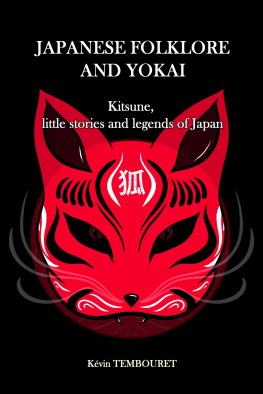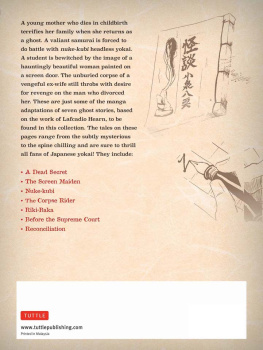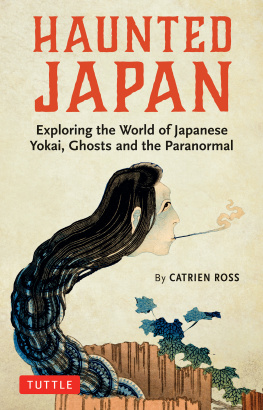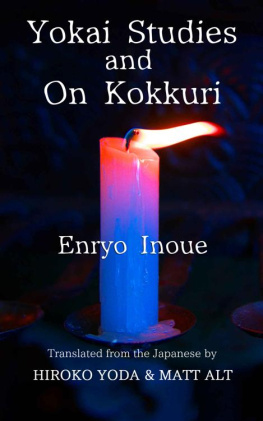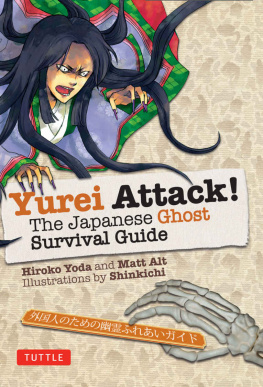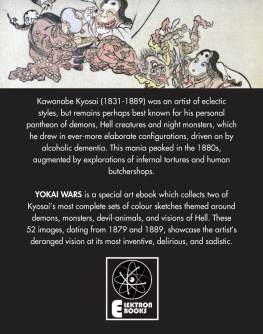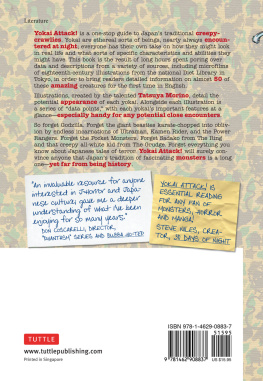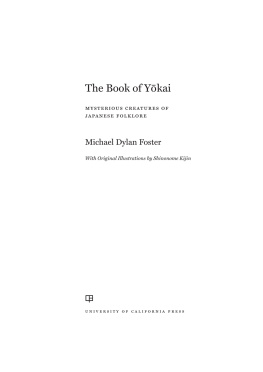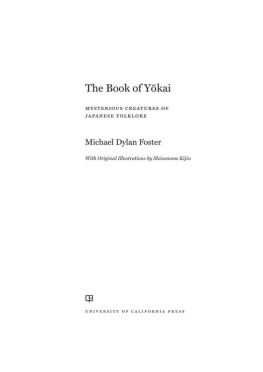Notes on the Translation
The Hepburn system of romanization is used for Japanese words, including the names of persons and places. Types of yokai, like other Japanese words not also established in English, are italicized, but the word yokai itself is not.
As a rule, Japanese names are presented in the Japanese order, family name first, with the exception of those who prefer the Western order (e.g. Hiroko Yoda). Historical figures are generally referred to by their family name where applicable, even where contemporary usage may have been otherwise in some cases (e.g. Inoue Enryo).
An Introduction to Yokai Culture: Monsters, Ghosts, and Outsiders in Japanese History
Komatsu Kazuhiko. Translated by Hiroko Yoda and Matt Alt.
Published by
Japan Publishing Industry Foundation for Culture (JPIC)
3-12-3 Kanda-Jinbocho, Chiyoda-ku, Tokyo 101-0051, Japan
First edition: March 2017
2006, 2012 by Komatsu Kazuhiko
English translation 2017 by Japan Publishing Industry Foundation for Culture
All rights reserved.
This book is a translation of Yokai bunka nyumon (KADOKAWA CORPORATION, 2012), which is a revised version of a book published under the same title by Serica Syobo in 2006.
English publishing rights arranged with KADOKAWA CORPORATION.
Book design by MIKI Kazuhiko, Ampersand Works
Jacket and cover images courtesy of International Research Center for Japanese Studies
ISBN 978-4-916055-80-4 (hardcover)
http://www.jpic.or.jp/japanlibrary/
An Introduction to Yokai Culture:
Monsters, Ghosts, and Outsiders in Japanese History
2017327
101-0051 3-12-3
03-5211-7282
http://www.jpic.or.jp/
2006, 2012 by Komatsu Kazuhiko
ISBN 978-4-916055-80-4 (hardcover)
JAPAN LIBRARY
CONTENTS
PREFACE to the English Edition
I n recent years, interest in yokai culture has continued to build in Japan. Yokai have never been so popular with the population at large in the postwar era. Every year, exhibitions of yokai art are held at museums and galleries across Japan, and the packaging of yokai culture in this way has thrust a great deal of once forgotten or poorly regarded art back into the light of day to charm modern audiences. Underlying all this is the remarkable progress and development of yokai scholarship in Japan.
When I began my own research into strange phenomena and the other world in Japan more than forty years ago, the majority of Japanese scholars viewed these subjects as vulgar and unworthy as topics of research. Many still considered yokai superstitions that hindered the progress of Japanese civilization, and few saw any merit in investigating these forgotten relics of the past. Indeed, as scientific, logical thinking has encroached on our lives, its only natural that yokai should have been pushed outthough, there are parts of Japan where people still believe in tengu , kappa , and other supernatural beings with mystical powers.
However, what interested me was not the question of whether yokai existed or not, but rather the abundance and proliferation of yokai and yokai-like symbols in Japanese culture, past and present. Some of these symbols were connected to sincerely held beliefs, but the majority were cultural products of pure imagination. Take, for example, the character Totoro from the Studio Ghibli film My Neighbor Totoro directed by Miyazaki Hayao. I suspect few, if any, believe Totoro truly dwells in a forest somewhere in Japan. He is enjoyed as a fictional creation.
This was what I wanted to study: yokai as cultural concepts and cultural products. The Japanese have long produced and consumed a great variety of yokai culture. The late Edo period, which corresponds to the early to mid-nineteenth century, was the golden age for yokai-related entertainment.
Yokai culture was more than just entertainment, however, making it a difficult subject to research. Yokai appear in a huge variety of cultural contexts in our daily lives: history, literature, painting, sculpture, performance, comics, animation, games, films, and even food. And yokai culture is not a relic of the past; it remains an inseparable part of modern culture that continues to evolve and even flourish. Anyone studying Japanese history or culture will encounter yokai, whether they recognize them as such or not. In fact, its no exaggeration to say that a deeper knowledge of yokai is a prerequisite for a deeper understanding of Japanese culture as a whole. This is why I call yokai a keyword for Japanese culture.
I also feel that Japans yokai culture is quite rich in comparison to similar cultures in other countries. This richness can be summarized in the following five points.
First, its long history. Starting in texts such as the eighth-century Kojiki ( Records of Ancient Matters ) and Nihon Shoki ( Chronicles of Japan ), then the Fudoki gazetteers and now modern electronic publications, yokai have appeared in a wide variety of media. Even outside such formal contexts, a great number of yokai stories have been told over the years, some collected in books like the medieval Konjaku monogatari shu (A Collection of Tales of Times Now Past) and some simply passed along in the oral tradition as legends or folktales.
Second is the abundance of figural and illustrated portrayals of yokai. I believe that the rich variety of art and sculpture produced by Japans yokai culture gives it a unique appeal. Yokai art began with depictions in works like the Kitano Tenjin engi emaki (Founding of Kitano Tenjin Shrine Picture-Scroll) of scenes from folktales and legends. In the Muromachi period (13361573), picture-scrolls solely about yokai began to appear, followed in the Edo period (16031868) by the compilation of yokai encyclopedias like the Gazu hyakki yagyo (An Illustrated Catalog of the Demons Night Parade). The end of that period saw a boom in yokai-themed color prints based on popular stories and horror performances.
Third is the sheer variety of yokai types found in folk societies. I was involved in creating the Strange Phenomena and Yokai Tradition Database at the International Research Center for Japanese Studies in Kyoto, as well as compiling its paper edition, Nihon kaii yokai daijiten (Encyclopedia of Strange Phenomena and Yokai of Japan), and they catalog an incredible number of yokai species. This is partly because of the animism underlying Japanese beliefs since ancient times, but it is also related to a penchant for attaching names to strange phenomena. Japans rich diversity of regional cultures appears to be another factor.
Fourth is the diversity in appearance of Japans yokai. There are two reasons for this. The first is the appearance of tsukumogami : tools and household objects that have come to life. The concept of transforming man-made tools into yokai by adding faces and limbs to bestow on them the characteristics of oni or animals took off in the medieval period. The second reason for the diversity of Japanese yokai is that, in the Edo period, artists harnessed their creative powers to create visual portrayals of previously formless or ill-defined yokai and mysterious phenomena. A great deal of illustrations and other depictions emerged as a result, and this artistic tradition is still alive and well in Japan.
Fifth is the cuteness of Japanese yokai. Even those that began as frightening presences became, over generations, characters and subjects for consumption as entertainment. This allowed yokai to insinuate themselves into every corner of daily life. Yokai playthings were made, yokai netsuke (kimono belt toggles) and inro (carrying cases) were carved, and more than a few food products came to be branded with yokai names. (The sak brands Tengu-mai and Oni-koroshi and the cucumber sushi roll known as kappa-maki are just a few examples.) Even today, yokai merchandise from the films of Studio Ghibli or the comic books of Mizuki Shigeru are some of Japans most popular products.


